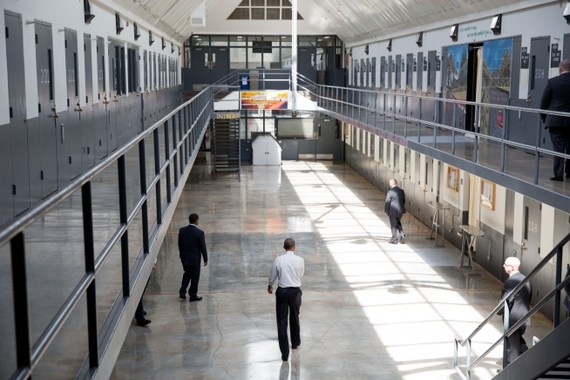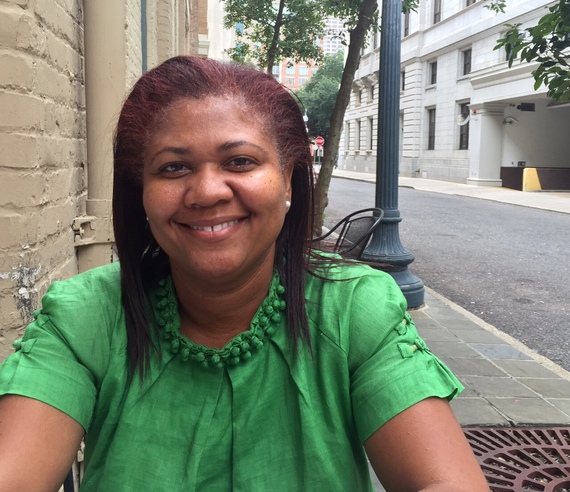Earlier this summer, President Obama became the first sitting president to visit a federal prison. Reflecting on his conversation with six inmates, he said:
When they describe their youth and their childhood, these are young people who made mistakes that aren't that different than the mistakes I made... The difference is they did not have the kinds of support structures, the second chances, the resources that would allow them to survive those mistakes.

President Barack Obama walks in the Residential Drug Abuse Prevention Unit at El Reno Prison after making a statement to the press, in El Reno, Okla., July 16, 2015. (Official White House Photo by Pete Souza)
Unfortunately, "support structures" and "second chances" are severely lacking for many in America today, particularly in minority and low-income communities. The United States has the most prisoners of any developed country in the world, both in terms of raw numbers and by percentage of the population. More citizens are behind bars in the US than in Russia, Mexico, Iran, India and China.
Who makes up America's prison population? Often inmates are adults who endured terrible violence and trauma as children, such as witnessing a parent's murder. A study by The Sentencing Project found that juveniles who received sentences of life in prison reported witnessing violence in their homes 79% of the time, and more than half (54.1%) witnessed weekly violence in their neighborhoods.
Children who are exposed to violence tend to suffer from a range of psychological issues, and often have "difficulties with attachment, regressive behavior, anxiety and depression and conduct problems." Without mental health support services, few are able to cope with the emotional stress in a productive manner on their own. Confused, angry or scared, a student's cries for help are commonly first expressed by acting out in school.
Regrettably, a school's frequent response to a student's "misbehavior" is ineffectual: just when the young person needs support and professional help the most, they are suspended, kicked back to the streets alone and vulnerable. According to the US Department of Education, the number of students who receive some form of academic suspension in America each year could fill 45 Super Bowl stadiums.
Once suspended, a student is nearly three times more likely to be in contact with the juvenile justice system within one year. For many, school suspension is the gateway to prison, a phenomenon known as the "school-to-prison pipeline." The aforementioned Sentencing Project report also found that the vast majority (84.4%) of juvenile lifers had been suspended at some point in their academic career.
Teachers, administrators, and politicians agree: the system is broken. Even in today's highly polarized political climate, the issue of criminal justice reform has garnered bipartisan support. On the same day that President Obama visited the federal penitentiary, Speaker John Boehner declared that he too has "long believed that there needed to be reform of our criminal justice system."
But to attempt to fix the criminal justice system without incorporating more robust psychological support services in our nation's public school systems would be a grave error. Studies indicate that programs that provide mental health services have a significant impact on lowering crime, improving academic performance, and boosting economic growth. For example, in 2004, Illinois expanded its alternative community programs while decreasing its reliance on detention. By 2007, detentions had dropped by 44% across the state's four pilot sites. The sites provided a variety of support services, including Aggression Replacement Training, Functional Family Therapy, and substance abuse treatment. For every $1 spent on the programs, $3.55 in incarceration costs was avoided.
Shonda Gray of Saint Louis, Missouri has seen first-hand the impact that such programs can have on transforming the lives of students who have experienced trauma or who, as was the case with President Obama, simply needed a second chance. While serving as Director of Innovative Education at Confluence Charter Schools, she was tasked with creating a program to help at-risk students socially and emotionally so that they could excel academically. She designed "The Ultimate Purpose Program," an in-school mental health service featuring group and personalized therapy sessions, as well as college and career coaching. Participating students' grades and attendance rose across the board. Several students who would once, as Gray put it, "curse their teacher out at any moment," transformed into college-bound community leaders. The program was so successful that Gray is now working to expand it into a small private school, "The Ultimate Purpose School."
This summer, Gray participated in a workshop at 4.0 Schools in New Orleans, Louisiana. Collaborating with fellow education entrepreneurs from across the country, she spent three days prototyping her idea. After the program, we sat down to discuss her journey building The Ultimate Purpose Program while working on the front lines with students, parents, teachers and her local community. What follows is our conversation.*
Q&A with Shonda Gray, Founder of The Ultimate Purpose School
MG: What is the mission of The Ultimate Purpose Program?
SG: The Ultimate Purpose Program helps students who've been impacted by traumatic events that have created barriers for them to move forward socially, emotionally and academically. I designed the program in St Louis, Missouri, where I served as the Director of Innovative Education at Confluence Charter Schools. I am now working to expand the program into a small, low-cost private school, The Ultimate Purpose School. It will provide wrap-around services for 5th-8th grade students who have experienced trauma and will hopefully open in Saint Louis for the 2016-17 academic year, and eventually expand nationwide.
MG: What types of issues do your students face?
SG: A mother, father, guardian, or close relative passing away. It could've been by murder, or a parent that's incarcerated. These students have also seen numerous murders. They've been impacted by constantly relocating; they're frequently in transition. We've found that these things all create academic achievement barriers as well as social and emotional barriers.
MG: Can you tell me about a particular student who's benefited from The Ultimate Purpose Program?
One is Yolanda. Her mom was murdered by her dad. Then the police ended up killing her dad. And her dad actually ended up shooting her (Yolanda) in the leg. These were two people she loved who, by her sophomore year, were gone, out of her life. So when I say "traumatic events" that happen to our students, this is a great example. To see her today, to have watched her go through the whole process, it's incredible. She currently has a 3.1 GPA. She had been one of our under-performing kids who would get easily frustrated. She would be very disrespectful to the teachers, even curse them out at any moment. But as we began to grow as a family and as a community in the program, all that changed. The students gathered around her; they created their own cohort, and pushed one another. Now Yolanda still does have barriers, and we do still have to encourage her, but she is on target to graduate in May 2016 and is on her way to college.
MG: Wow. Could you share another student's story?
SG: Yes. Danita came to our program with a learning disability and a traumatic childhood. She witnessed her dad deal drugs and then get murdered in front of her when she 5 was years old. We didn't know what had happened until she shared with us in a group session. Now she tells this story, which I can tell you because she's given me permission. We've watched her transform into a confident young lady. She received a scholarship to put towards her college education from the YWCA and she's been in several leadership programs. And she is on target to graduate with a 3.8 GPA, and is anticipating going to Missouri State University for a degree in Aerospace Engineering.
MG: What was the turning point for her?
SG: Exposure. In the program we connect students with a lot of community groups and diversity programs. Constant college visits. We even took this particular group of kids on out-of-state college visits. The thing is to continue to expose them to college and career readiness opportunities, to really ingrain in their heart: "I am able to do this; this is what I am going to do." It's very encouraging to watch them turn their life around.
MG: How does a student typically behave in school after they've experienced a traumatic event?
SG: The sad part is that it's almost like the norm for a lot of the kids that come into the program. They treat it as if it's a normal event. They come to school and you wouldn't necessarily know that something happened until one of the other students, or a counselor or parent, shares what happened. Or, you may have even seen it on the news the night before. Even then, most of them come in as if it's a normal day. Then you begin to see the sadness. You begin to see the disengagement in the classroom. The body language changes. The behavior changes; you have a lot more outbursts or disrespect to teachers or staff.
MG: What are some tips you would offer a teacher to help his or her students cope with a traumatic event?
SG: Learn who the student is. Look past the behavior. Look past the person right then who's sitting in front of you. Try to get past whatever that student is doing at that time that's making teaching challenging. Try to look past that at that moment and have compassion and empathy for that student. You might get a lot of anger that comes back. In a professional way, you have to love them past what you're seeing in the classroom. That means you have to have a place in your heart for the students you're serving. You have to continue to push past those barriers. Not forcefully - but take your time in doing it. Be consistent.
MG: Are there additional resources out there for teachers and administrators who'd like to learn more?
SG: Teachers attend all these different sessions on Common Core or on their content area. But I would start attending sessions on social and emotional needs. You may not be a counselor by title, but you really are in the classroom. For administrators, I would bring in grief counselors or community groups that provide psychological services to work on PD (Professional Development) with your teachers, not your counselors or social workers, your teachers.
MG: What advice would you offer a teacher who's preparing to reach out to a parent for the first time after learning of a traumatic event in the life of his or her student?
SG: The same approach as for the student: be compassionate and consistent. But learn to step back when they say no. Initially they have barriers up because they have trust issues when they come into the door. In order for them to share, just step back and don't say too much. Give them your condolences for what just happened. Say that if you could be any help let them know they can contact you. That's how the initial doors open. But being consistent with their child will open the door even further.
MG: What is one of the biggest misconceptions about your work that you have to constantly explain to people who aren't familiar with it?
SG: That these kids are bad. They've been labeled as bad. That is the biggest fight in working with the kids is trying to undo all these negative seeds that've been put in them over the years. They never really knew what was going on. [They're] Like, "Yeah I have these feelings, but how do I express these feelings?" Sometimes as educators we just look at the behavior and we're quick to suspend the kid without really knowing what's the root of the issue. You can suspend a kid, but when that kid comes back, you're still going to have to deal with the same thing. So what happens is the kids become repeat offenders. You never got to the root of the issue. Then you end up with a kid that drops out of school, and decides not to come back, and just says, "Forget it."
MG: How do you get to the root of the issue?
SG: The best way is to continue to work with the students to try to figure out a way forward. Say: "Hey, how can we get you through this process? What do we need to do to help you? What do you think you need to do to help you?" Those are the questions that we pose to every student that comes into the program. So, the students have a choice to be in the program, or not. They also sign off and agree with a parent or guardian. They say "Okay, let's try this for a year." The students are allowed to stay in the program over a year if they choose to, and that's what normally happens.
MG: Do you have any stats on how The Ultimate Purpose Program has impacted student performance academically?
SG: Oh yes. We had 100% graduation rate for the 2013-14 school year, and 100% of Ultimate Purpose Program students increased their GPA. Last year 48% of our new students increased their attendance, and 57% of new students increased their GPA. These are just some of the results we see. And they are especially important because many of these students have never shown advancement in the past.
MG: Amazing. What inspired you to get into this work?
SG: I realized that it's my passion, and it's my ministry, so I don't look at it as a job.
---
For additional information about suspension and its prevalence in your area, check out this interactive map on "The Hidden Cost of Suspension." To begin to learn more about teaching practices that support social and emotional learning, see The Whole Child.
*This interview has been edited slightly in order to protect the identity of students and to accommodate space restrictions. It originally appeared on the Young Education Professionals' Recess blog, and has been republished with permission.


